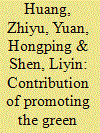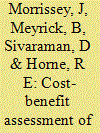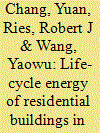| Srl | Item |
| 1 |
ID:
116951


|
|
|
|
|
| Publication |
2012.
|
| Summary/Abstract |
Green residence development has been one of the important strategies for promoting sustainable urban development. Governments throughout the world have been encouraging property developers to deliver green properties. In line with this development, governments have been implementing various assessment programs to certify green residential buildings with the aim of contributing to sustainable urban development. With reference to the Chinese construction practice, this paper examines the effectiveness of the green residence assessment scheme toward its defined aim through investigating the contents and procedures of the green residence assessment scheme by referring to the practices of Chongqing city in western China. Based on the results of five case studies and five semi-structured interviews, this study reveals the significant contribution from implementing the green residence assessment scheme particularly to energy saving in residential buildings. Further, the green residence assessment scheme promotes the application of green building materials and green construction technologies in the entire process of delivering and operating residential buildings. The findings provide valuable references for further investigating alternative methods to achieve better energy saving in developing residential buildings.
|
|
|
|
|
|
|
|
|
|
|
|
|
|
|
|
| 2 |
ID:
118831


|
|
|
|
|
| Publication |
2013.
|
| Summary/Abstract |
This article focuses on the impact of the discount rate on cost-benefit assessment of investment options for residential building efficiency. An integrated thermal modeling, life cycle costing approach is applied to an extensive sample of dominant house designs for Australian conditions. The relative significance of predicted thermal performance and the applied discount rate on the Present Value of energy savings from alternative investment scenarios is investigated. Costs and benefits are also evaluated at the economy-wide scale, including carbon pricing considerations, and for a test-case household faced with alternative investment options at the point of construction. The influence of the applied discount rate on produced cost-benefit calculations is investigated, as is the interaction between critical cost-benefit input parameters. Findings support that the discounting framework is the primary driver of difference in estimates about costs and benefits of higher standards of efficiency in the residential sector. Results demonstrate that agreement on a low discount rate based on sustainability principals would prioritise those projects with significant environmental benefits.
|
|
|
|
|
|
|
|
|
|
|
|
|
|
|
|
| 3 |
ID:
133115


|
|
|
|
|
| Publication |
2014.
|
| Summary/Abstract |
Building energy efficiency rating systems have been established worldwide to systematically manage the energy consumption of existing buildings. This study aimed to develop a new energy efficiency rating system for existing residential buildings from two perspectives: (i) establishment of reasonable and fair criteria for the building energy efficiency rating system; and (ii) establishment of comparative incentive and penalty programs to encourage the voluntary participation of all residents in the energy saving campaign. Based on the analysis of the conventional energy efficiency rating system for existing residential buildings, this study was conducted in five steps: (i) data collection and analysis; (ii) correlation analysis between the household size and the CO2 emission density (i.e., CO2 emission per unit area); (iii) cluster formation based on results of the correlation analysis using a decision tree; (iv) establishment of a new energy efficiency rating system for existing buildings; and (v) establishment of incentive and penalty programs using advanced case-based reasoning. The proposed system can allow a policymaker to establish a reasonable and fair energy efficiency rating system for existing residential buildings and can encourage the voluntary participation of all residents in the energy saving campaign.
|
|
|
|
|
|
|
|
|
|
|
|
|
|
|
|
| 4 |
ID:
125761


|
|
|
|
|
| Publication |
2013.
|
| Summary/Abstract |
In the context of rapid urbanization and new construction in rural China, residential building energy consumption has the potential to increase with the expected increase in demand. A process-based hybrid life-cycle assessment model is used to quantify the life-cycle energy use for both urban and rural residential buildings in China and determine the energy use characteristics of each life cycle phase. An input-output model for the pre-use phases is based on 2007 Chinese economic benchmark data. A process-based life-cycle assessment model for estimating the operation and demolition phases uses historical energy-intensity data. Results show that operation energy in both urban and rural residential buildings is dominant and varies from 75% to 86% of life cycle energy respectively. Gaps in living standards as well as differences in building structure and materials result in a life-cycle energy intensity of urban residential buildings that is 20% higher than that of rural residential buildings. The life-cycle energy of urban residential buildings is most sensitive to the reduction of operational energy intensity excluding heating energy which depends on both the occupants' energy-saving behavior as well as the performance of the building itself.
|
|
|
|
|
|
|
|
|
|
|
|
|
|
|
|